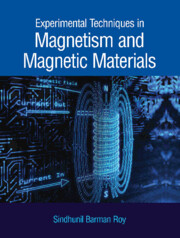Book contents
- Frontmatter
- Dedication
- Contents
- Preface
- I Introduction to Magnetism and Magnetic Materials
- II Basic Phenomenology of Magnetism
- III Experimental Techniques in Magnetism
- Appendix A Magnetic Fields and Their Generation
- Appendix B Units in Magnetism
- Appendix C Demagnetization Field and Demagnetization Factor
- Index
3 - Magnetic Moment and the Effect of Crystal Environment
Published online by Cambridge University Press: 27 October 2022
- Frontmatter
- Dedication
- Contents
- Preface
- I Introduction to Magnetism and Magnetic Materials
- II Basic Phenomenology of Magnetism
- III Experimental Techniques in Magnetism
- Appendix A Magnetic Fields and Their Generation
- Appendix B Units in Magnetism
- Appendix C Demagnetization Field and Demagnetization Factor
- Index
Summary
Magnetic Moment and Magnetization
When we examine a magnetic material, it is first essential to identify parameters that characterize the response of the magnetic material to an applied magnetic field. We will see that these parameters are magnetic moment and magnetization.
Magnetic Moment
All of us at some point in our lives have come across magnets and experienced the strange forces of attraction and repulsion between them. These magnetic forces appear to originate in regions called poles, which are located near the ends of, say, a bar magnet. In magnets, poles always occur in pairs, but it is impossible to separate them. A magnetic field is created by a magnetic pole, which pervades the region around the pole [2]. This magnetic field causes a force on a second pole nearby. This magnetic force is directly proportional to the product of the pole strength p and field strength or field intensity H, which can be verified experimentally:
This equation defines H if the proportionality constant k is put equal to 1. A magnetic field of unit strength causes a force of 1 dyne on a unit pole [2]. In CGS units, a field of unit strength has an intensity of 1 oersted (Oe).
Let us now consider a bar magnet with poles of strength p located near each end and separated by a distance l, which is placed at an angle θ to a uniform field B = μ0H(Fig. 3.1). The magnet will experience a torque, which will tend to turn the magnet parallel to the magnetic field. The moment μof this torque is expressed as [2]:
When H= 1 Oe and θ = 900 , the moment is given by μ = pl. The magnetic moment of the magnet is defined as the moment of the torque experienced by the magnet when it is at right angles to a uniform field of 1 Oe. In a non-uniform magnetic field, the magnet will also feel a translational force acting on it. We will see in the subsequent sections that magnetic moment is a fundamental quantity for magnetism in materials.
- Type
- Chapter
- Information
- Publisher: Cambridge University PressPrint publication year: 2023

